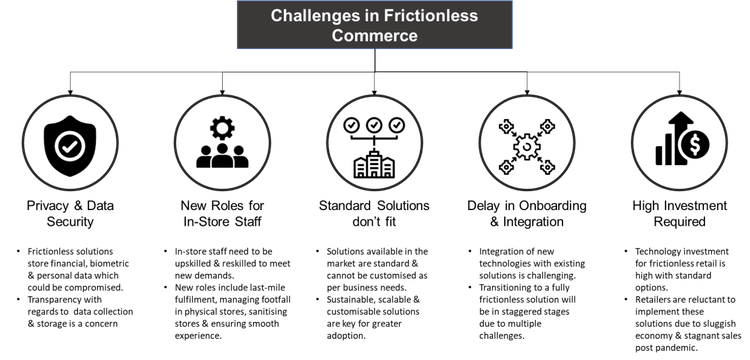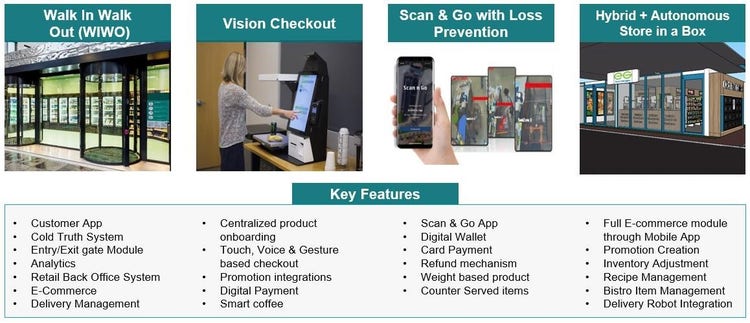

Insights
How to address challenges and opportunities in frictionless commerce
Subhodip Bandyopadhyay General Manager- Emerging Digital Technology, UST
An exploration of challenges and objections to frictionless commerce and how a hybrid solution solves them.

Subhodip Bandyopadhyay General Manager- Emerging Digital Technology, UST
The frictionless commerce experience can drive customer satisfaction and ensure customer loyalty in the future. From order placements to pick-up and delivery to payments, it provides a differentiated solution that improves operational efficiency while keeping customers and employees safe and happy.
Retailers must modernize their brick-and-mortar stores within an omnichannel framework that integrates all channels seamlessly into one whole. Customers want to browse anywhere, buy anywhere, and have their orders fulfilled anywhere, and retailers need to deliver on all three of these at scale.
Innovative frictionless (e.g., contactless) solutions make the shopping experience seamless and benefit retailers by boosting footfall, which leads to higher revenue. Reducing associated labor and sanitation costs and increasing revenue ultimately increases profitability.
However, any new technology-based system introduces new challenges, especially when a one-size-fits-all approach does not work. In this post, we will discuss some of the most common challenges spurred by frictionless commerce and how they are best remedied.
While frictionless commerce incorporates many technologies, we will focus primarily on frictionless checkout.
Nearly 70% of consumers ranked checkout experience as one of the most important factors shaping their perception of a store.
These innovative solutions provide a seamless shopping experience, enriching the customer experience. While it’s a competitive advantage now, it will become more of a status quo in the future, leaving behind those who do not adapt. By 2030, machines, not human staff, will fulfill 67% of customer engagement.

Privacy and data security
Frictionless systems require immense amounts of data from users. Any time a company collects data on its customers, there exists the possibility that it can be misused, either intentionally or accidentally. In addition, smartphone apps used to interact with contactless systems are susceptible to malware attacks that can access information stored on the device, such as bank account numbers, personal information, biometric data, etc.
There is a growing concern among consumers regarding data privacy, and frictionless solutions must eliminate any loopholes to lay a strong foundation for future adoption.
Solution
Any frictionless commerce implementation must include robust DevSecOps, which requires customization to the business’s unique operations.
New roles for in-store staff
Frictionless systems can change the roles of in-store staff. They replace the need for cashiers, opening opportunities to serve customers better proactively by helping them find items, answering their questions, and monitoring for any issues. The staff in frictionless stores play a crucial role in last-mile fulfilment, managing foot traffic in physical spaces, and ensuring that cleaning and sanitizing procedures are carried out thoroughly.
Solution
Change is hard, especially for employees that are worried about their jobs. Retailers and other brick-and-mortar businesses should be transparent about the importance of adopting frictionless commerce and how it can aid in the business’s overall competitiveness. They must convey its impact on customer experience, customer satisfaction and, just as important, employees’ health and safety. They need to reassure employees that they are still valuable members of the team, but the one-size-fits-all approach in their day-to-day roles might change. Using data to support your story, one should walk them through a frictionless store setup, how it works, and why it's valuable.
Post the transparent communication, they need to focus on training employees to operate within the new structure. They need to provide employees with the right tools and training to carry out new tasks. Upskilling and reskilling staff are critical to tackling advanced safety protocols and service concerns.
Prevalence of standardized solutions
Businesses that started adopting these frictionless solutions failed to identify the gaps between their requirements and the available solutions. But, that changed with the pandemic, where they had to bear the brunt of lower footfalls due to the demand for innovative frictionless solutions.
Some frictionless solutions are available for retail store owners operating in supermarket and convenience store segments. But these are standardized solutions and are not readily customizable for business needs. Zero or limited customization is one of the primary reasons small and medium retailers are reluctant to upgrade to frictionless solutions as they don't have capital or infrastructure for significant in-store changes.
Solution
Building a frictionless commerce experience requires customization to cater to unique business needs. The solution must support the growth of store owners and provide satisfactory ROI. Therefore, selecting scalable and sustainable technologies is critical for a smooth growth experience.
Delay in onboarding and integration
Retailers who have integrated the technology in the past have encountered implementation delays that have made them reconsider new investments. That has a cascading effect on the adoption of frictionless technology, where executives worry the roadmap will be prohibitively long and will hurt sales in the short term until it is operational.
Solution
By working with a technology-agnostic, dedicated partner with years of experience in this emerging field, retailers can confidently invest in the right solution. For example, UST builds minimalistic solutions, eliminating components that are not needed and using minimum shopfloor area, enabling the likelihood of scaling the solutions across multiple stores.
Consumer preference
Not everyone is comfortable with frictionless commerce. Some prefer talking to a real person, while others could worry about their personal information being stolen or being scammed.
Solution
A hybrid approach provides the best of both worlds: frictionless checkout and traditional human-operated checkout.
Significant investment required
Retailers dealing with challenging environments are also trying to maintain margins in an inflationary market. They’ve also had to invest in sanitization and health and safety technology.
Traditional frictionless retail technology solutions for supermarkets and convenience stores are prohibitively expensive for most business owners and may cause a large-scale disruption in operations if implemented. Store owners are struggling to survive, and incorporating the added cost of infrastructure investment for frictionless solutions into their tight budget can significantly affect their margins. Thus, they are reluctant to adopt frictionless solutions readily.
Solution
The efficiency of the new technology and potential boost in sales are factors that retailers are taking into consideration before opting for fully automated frictionless solutions. The focus on customer experience for the long run and preparedness for frictionless retail will define the success or failure of business strategy implementation.

UST, a leading digital transformation player, provides a smart hybrid solution that provides both frictionless and traditional checkout options.
Over the last few years, UST, with its deep expertise in the retail space, has built multiple innovative frictionless commerce solutions such as Walk-In Walk-Out (WIWO), Vision Checkout, Autonomous store in a box, Scan and Go with Loss prevention, etc. These solutions are tested and implemented across retailers who reaped multiple benefits from these UST's frictionless commerce solutions.
To learn more about our unique approach, download our eBook Frictionless Commerce for retail in 2022 and beyond.